Well, it’s been quite a busy past few months. My three-country road trip in August and September to get the rest of my stuff from my mom and dad’s house in Massachusetts was the highlight. I’ve been busy since I got back, re-touching and refinishing the furniture I brought out and unpacking the rest of everything.
Anyway, I can’t believe fall is already here in Phoenix. It’s time to start thinking about putting my garden back into winter mode. Here in the low deserts of Arizona, growing season is backwards from what you would expect. It starts in late August/early September and runs through the end of May. I’ve got some ambitious goals for this winter, but they will build a great foundation for future gardening here in Arizona.
My Foray into Winter Greenhouse Gardening in Arizona
For those of you that don’t know, about 2 years ago, I built a plant cage to house my potted plants (herbs and veggies) to keep the ground squirrels and other varmint out of my plants. Right before I built the plant cage, the ground squirrels ate my entire garden down to stumps. As you can probably guess, I was not happy, and the wars with the ground squirrels officially began.
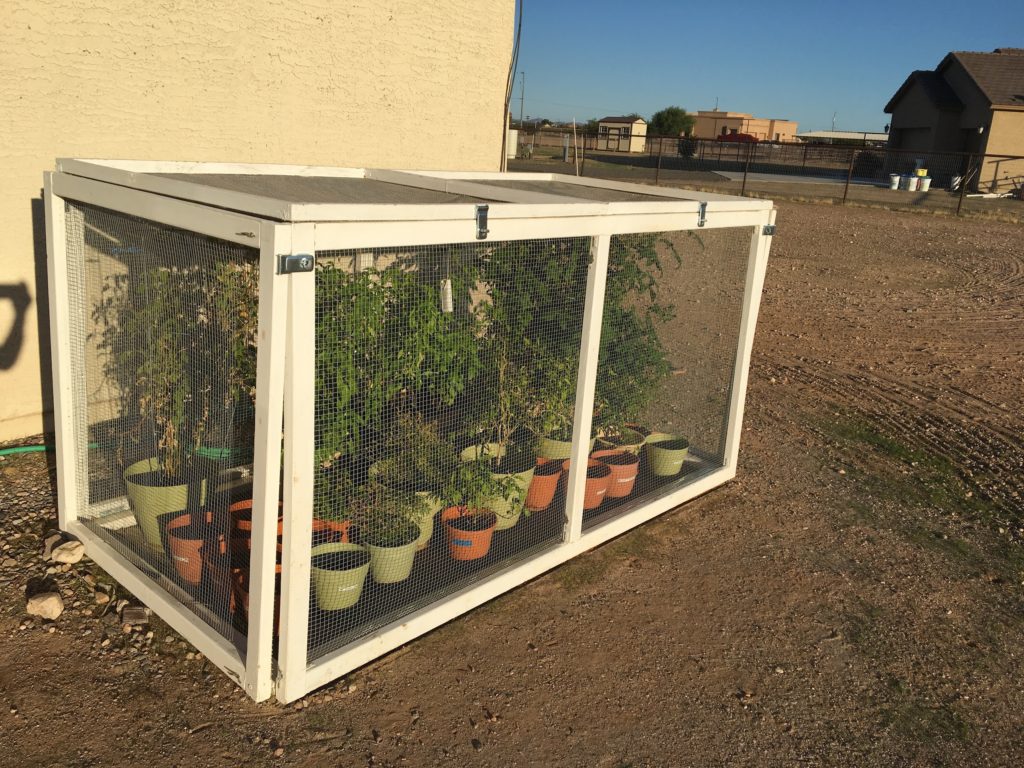
In the winter, I put plastic on the plant cage, effectively turning it into a greenhouse. The greenhouse allows my cold-sensitive plants to winter over outside. Even here in the Phoenix area, winter nights are too cold for my peppers, tomatoes, and basil without some kind of protection.
Last winter was my first venture into greenhouse gardening in Arizona. I built a heating system to protect the plants from the cold. It worked (we had nights down to 22°F), but it was both a lot of effort and expensive to maintain it throughout the winter, even in Phoenix. I need to make some changes this year. Which is a perfect segue into this year’s gardening goals and ambitions.
Goal #1: Greenhouse Must Be Easier to Maintain and More Cost-Effective
To upgrade the greenhouse for last winter, I plan to implement the following changes and upgrades:
- Integrate smart home technology/automation into the heating system to give me much finer control and monitoring of the climate control.
- To decrease costs, reduce the night time temperature/heat setting inside the greenhouse from 67°F to 55°F.
- Add insulation (clear bubble-wrap) to the sides and top of the greenhouse.
- The cost of adding the insulation should more than pay for itself over the course of the winter.
- I shouldn’t need to cover the greenhouse unless nighttime temperatures drop below 45°F.
- With the added insulation, I should be able to cover the greenhouse with frost cloths, which are much easier to put on and take off, and still maintain 55°F inside.
- I only want to have to use the big tarp if temperatures drop below freezing, it rains, or you have high winds combined with chilly temperatures.
Update December, 2019: These upgrades have worked flawlessly so far. During a couple cold nights in October, the frost cloths and the heater were able to hold 57°F without any plastic or insulation on the plant cage with outside temperatures down to 35°F. I have only had to use the big tarp two nights, when we had wind gusts to 80 km/h (50 mph). I bought a smaller light-duty tarp to use when it rains. It’s essentially used like a rain fly on a tent. The smaller tarp is much nicer to use than the big heavy-duty tarp, which covers the entire greenhouse.
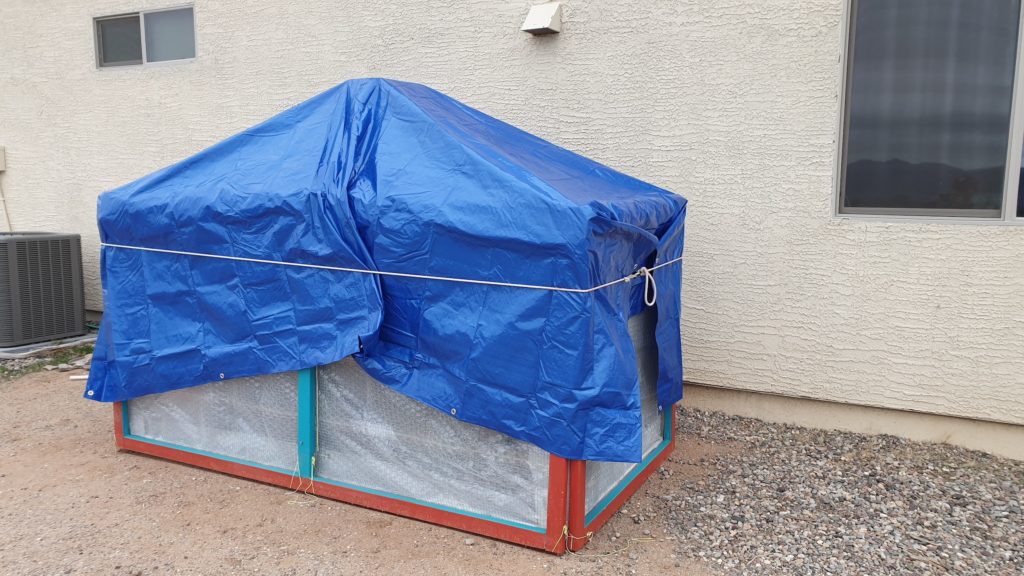
Goal #2: Add an Indoor Herb Garden
The motivation for adding an indoor herb garden stems from all of the times I wanted a stalk of basil, a sprig of cilantro, or a couple of cherry tomatoes while I cooked dinner, and the greenhouse had already been put to bed for the night (you can’t get into it once it’s put to bed for the night).
I have huge south and east-facing windows in my kitchen, so it was a no-brainer where to put the indoor herb garden. The space around the window is essentially just dead space right now. An indoor garden will be a nice addition.
The challenge of the indoor garden was finding a table that the potted plants could sit on. A standard table was way too wide and not tall enough. I started looking at console tables, which are long, skinny tables that often go right behind sofas. Again, I couldn’t find one that was the right length or height, so I finally decided to just build one myself. I am so glad I did. It was a really fun project to work on over the long Columbus Day Weekend and it fits in just perfectly in my kitchen.
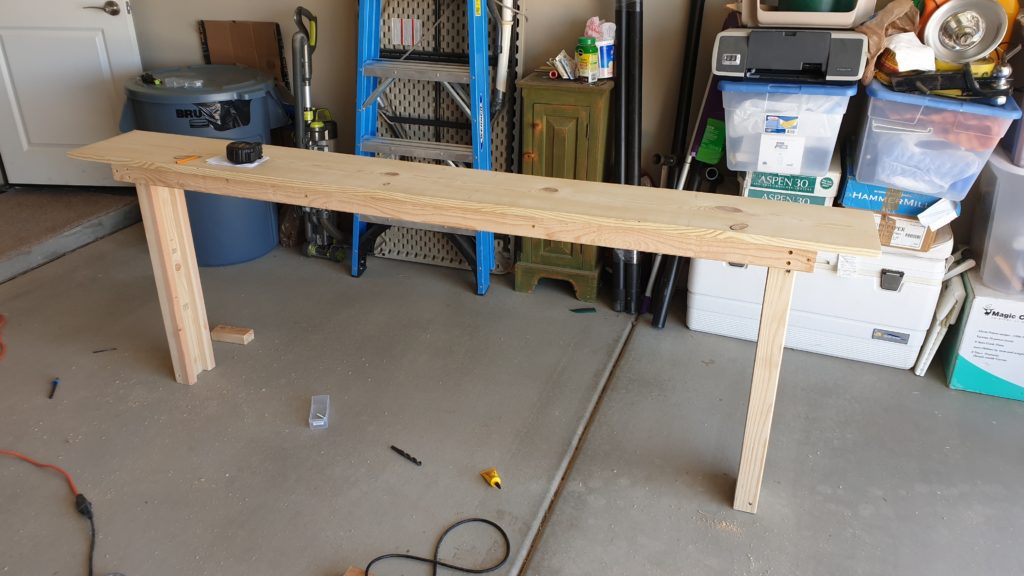
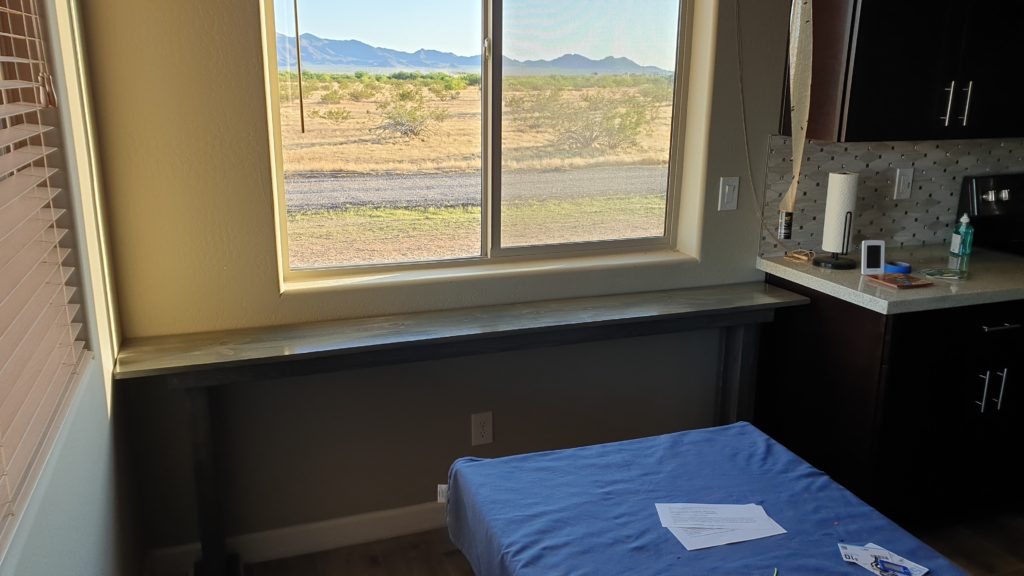
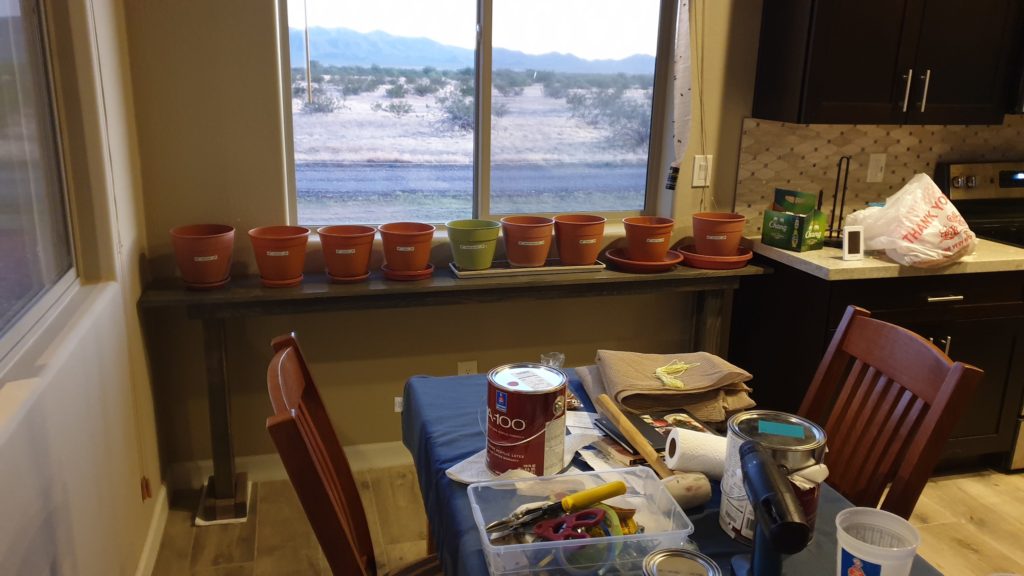
I have currently have cilantro, scallions, peppermint, oregano, rosemary, and four different types of basil (Italian, Thai, Mexican, and Sweet) in my indoor garden.
Goal #3: Paint the Plant Cage
When I built the plant cage two years ago, I didn’t have much money to spare. The company I was working for at the time had just gone under. I knew the elements would destroy the bare wood, so I painted it the (cheapest and) most redneck color I could find: primer.
While the primer worked fine, I have always wanted to paint it with a nice southwestern color scheme. The plant cage gets moved between its summer and winter homes twice per year. That’s the perfect oppotunity to catch up on maintenance, including painting. I wanted to paint it last spring, but ground squirrel activity peaks that time of year. There has been basically no ground squirrel activity this fall, so this is the perfect time to paint it. I found some nice southwestern colors at Sherwin Williams and will be painting it this weekend.
Update October, 2019:
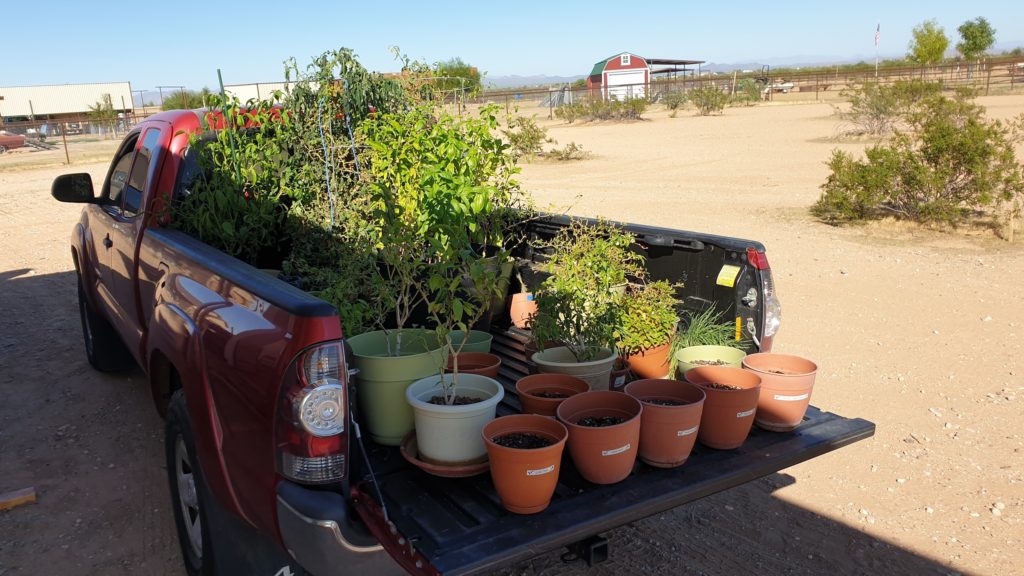
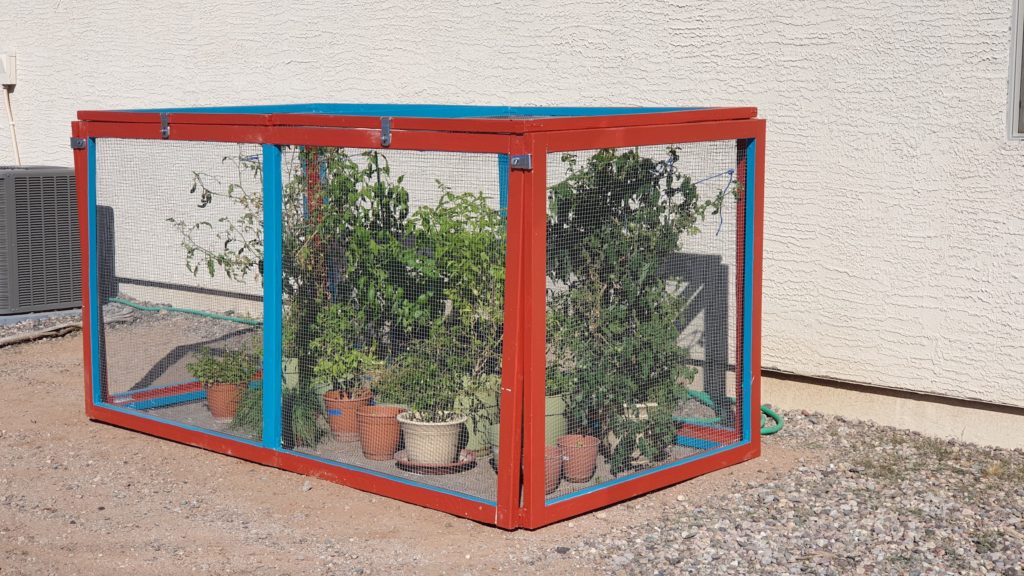
Goal #4: Plant Winter Veggies
I learned the hard way last year that winter veggies will fail miserably if you plant them too late. I planted them in mid-December, and the only successful veggie I grew was lettuce. This year, I planted my winter veggies in late September: spinach, lettuce, cilantro, and broccoli.
Update December, 2019: The lettuce, spinach, and cilantro are overflowing the outdoor whiskey barrel planter. The broccoli has not set heads yet, but they’re growing like crazy.
Goal #5: Begin Designing Raised Beds for the Yard
While the 8-foot by 4-foot plant cage is all well and good, I have an acre of land here and it’s time to put it to work. Since not much grows in the desert soil, raised beds are the best option for both summer and winter gardening in Arizona. Unfortunately, we still have the ground squirrel/pest issue we need to deal with, so the raised beds need to be ground squirrel-proof.
Ground squirrels are cunning, very smart, and absolutely relentless. They will not stop until they get what they want. They will try to go over, under, and through any obstacle to get it. Most of the raised bed design is to squirrel-proof it, but the good news is that squirrel-proofing the raised beds will also keep the rabbits, mice, and other pests out. While I am far from finalizing a design, this is what I’m leaning towards/thinking about doing right now:
- Put some kind of large gravel or crushed concrete blocks to prevent the squirrels from digging underneath.
- Extend the frame at least 6-12 inches underground to prevent digging underneath
- Put sides with hardware cloth at least 1 foot high so pests can’t just jump into the raised bed. I’m still working on determining how cost effective this will be
- Put electric fencing wire around the top so anything that tries to climb over will get zapped. Assuming that this actually works, the electric fence will be solar powered so that I don’t need to run power out to the garden.
I’m hoping to build a prototype of the raised bed this winter/spring, but I’m not sure whether that will actually happen or not.
Winter gardening in Arizona is a unique experience with its own set of challenges. When done correctly, it’s incredibly rewarding. It can provide you with a lush, flourishing garden you’d never think would be possible in the desert.